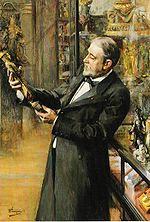
Émile Étienne Guimet
Encyclopedia

France
The French Republic , The French Republic , The French Republic , (commonly known as France , is a unitary semi-presidential republic in Western Europe with several overseas territories and islands located on other continents and in the Indian, Pacific, and Atlantic oceans. Metropolitan France...
industrialist, traveler and connoisseur
Connoisseur
A connoisseur is a person who has a great deal of knowledge about the fine arts, cuisines, or an expert judge in matters of taste.Modern connoisseurship must be seen along with museums, art galleries and "the cult of originality"...
.
He was born at Lyon
Lyon
Lyon , is a city in east-central France in the Rhône-Alpes region, situated between Paris and Marseille. Lyon is located at from Paris, from Marseille, from Geneva, from Turin, and from Barcelona. The residents of the city are called Lyonnais....
and succeeded his father
Jean-Baptiste Guimet
Jean-Baptiste Guimet , French industrial chemist, was born at Voiron, Isère.He studied at the École Polytechnique in Paris, and in 1817 entered the Administration des Poudres et Salpêtres...
in the direction of his "artificial ultramarine"
Ultramarine
Ultramarine is a blue pigment consisting primarily of a double silicate of aluminium and sodium with some sulfides or sulfates, and occurring in nature as a proximate component of lapis lazuli...
factory. He also founded the Musée Guimet, which was first located at Lyon in 1879 and was handed over to the state and transferred to Paris in 1885.
Devoted to travel, he was in 1876 commissioned by the minister of public instruction to study the religions of the Far East
Far East
The Far East is an English term mostly describing East Asia and Southeast Asia, with South Asia sometimes also included for economic and cultural reasons.The term came into use in European geopolitical discourse in the 19th century,...
, and the museum contains many of the fruits of this expedition, including a fine collection of Japanese and Chinese porcelain
Porcelain
Porcelain is a ceramic material made by heating raw materials, generally including clay in the form of kaolin, in a kiln to temperatures between and...
and many objects relating not merely to the religions of the East but also to those of Ancient Egypt
Ancient Egypt
Ancient Egypt was an ancient civilization of Northeastern Africa, concentrated along the lower reaches of the Nile River in what is now the modern country of Egypt. Egyptian civilization coalesced around 3150 BC with the political unification of Upper and Lower Egypt under the first pharaoh...
, Greece
Greece
Greece , officially the Hellenic Republic , and historically Hellas or the Republic of Greece in English, is a country in southeastern Europe....
and Rome
Rome
Rome is the capital of Italy and the country's largest and most populated city and comune, with over 2.7 million residents in . The city is located in the central-western portion of the Italian Peninsula, on the Tiber River within the Lazio region of Italy.Rome's history spans two and a half...
.
He wrote Lettres sur l'Algerie (1877) and Promenades japonaises (1880), and also some musical compositions, including a grand opera, Tai-Tsoung (1894).

